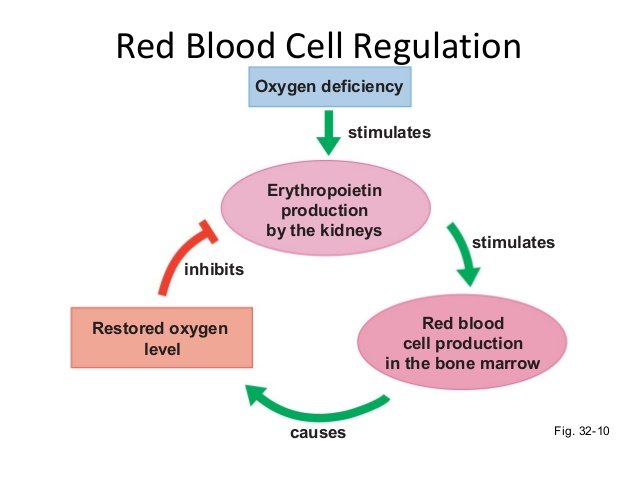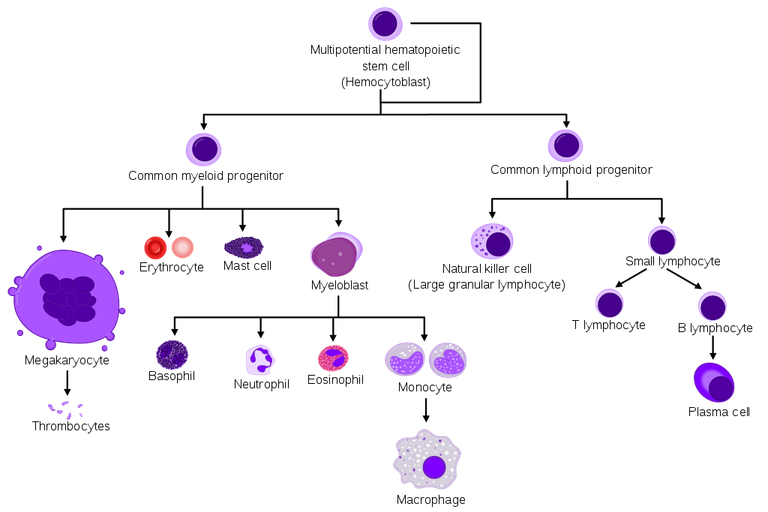Hemoglobin is the protein inside red blood cells that carries oxygen. Red blood cells also remove carbon dioxide from your body, transporting it to the lungs for you to exhale. Red blood cells are made inside your bones, in the bone marrow. They typically live for about 120 days, and then they die. [1]

How Regulation of Blood Cell Production
In children the marrow of most bones produces blood cells. By adulthood, however, only the bones of the chest, the base of the skull, and the upper portions of the limbs remain active. The bone marrow in an adult weighs almost as much as the liver, and it produces cells at an enormous rate.

Image credit
All blood cells are descended from a single population of bone marrow cells called pluripotent hematopoietic stem cells, which are undifferentiated cells capable of giving rise to precursors (progenitors) of any of the different blood cells. When a pluripotent stem cell divides, its two daughter cells either remain pluripotent stem cells or become committed to a particular developmental pathway; what governs this “decision” is not known.
The first branching yields either lymphoid stem cells, which give rise to the lymphocytes, or so called myeloid stem cells, the progenitors of all the other varieties. At some point, the proliferating offspring of the myeloid stem cells become committed to differentiate along only one path, for example into erythrocytes.
Proliferation and differentiation of the various progenitor cells is stimulated, at multiple points, by a large number of protein hormones and paracrine agents collectively termed hematopoietic growth factors (HGFs). Thus, erythropoietin, the hormone described earlier, is an HGF. (Nomenclature can be confusing in this area since the HGFs belong to a still larger general family of messengers termed “cytokines".
Physiology of hematopoietic growth factors
The physiology of the HGFs is very complex because (1) there are so many of them, (2) any given HGF is often produced by a variety of cell types throughout the body, and (3) HGFs often exert other actions in addition to stimulating blood cell production. There are, moreover, many interactions of the HGFs on particular bone marrow cells and processes. For example, although erythropoietin is the major stimulator of erythropoiesis, at least 10 other HGFs cooperate in theprocess. Finally, in several cases the HGFs not only stimulate differentiation and proliferation of progenitor cells, they inhibit the usual programmed death of these cells.
The administration of specific HGFs is proving tobe of considerable clinical importance. Examples are the use of erythropoietin in persons having a deficiency of this hormone due to kidney disease, and the use of granulocyte colony stimulating factor (G-CSF) to stimulate granulocyte production in individuals whose bone marrow has been damaged by anticancer drugs.
Hi! I am a robot. I just upvoted you! I found similar content that readers might be interested in:
https://www.78stepshealth.us/body-function/regulation-of-blood-cell-production.html
https://shapeshift.zendesk.com/hc/en-us/community/posts/115000612704-eBTC-addition
Cool! I follow you.
Congratulations @mulwisdom! You have received a personal award!
Click on the badge to view your Board of Honor.
Do not miss the last post from @steemitboard:
SteemitBoard and the Veterans on Steemit - The First Community Badge.
Congratulations @mulwisdom! You received a personal award!
You can view your badges on your Steem Board and compare to others on the Steem Ranking
Vote for @Steemitboard as a witness to get one more award and increased upvotes!
Congratulations @mulwisdom! You have completed the following achievement on the Hive blockchain and have been rewarded with new badge(s):
Your next target is to reach 50 replies.
You can view your badges on your board and compare yourself to others in the Ranking
If you no longer want to receive notifications, reply to this comment with the word
STOPSupport the HiveBuzz project. Vote for our proposal!